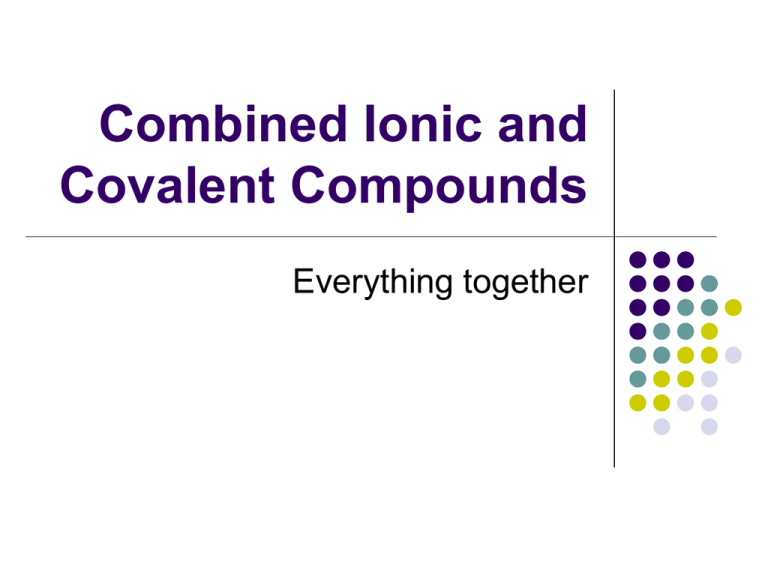Combined Ionic and Covalent Compounds
advertisement

Combined Ionic and Covalent Compounds Everything together Properties of Ionic Compounds 1. 2. 3. 4. 5. 6. 7. Electrons are transferred (Made of Ions) Metal and a Nonmetal present (except NH4+ may be present) High Melting Points High Boiling Points Normally Solids at Room Temperature Conduct electricity when liquid or dissolved Normally dissolve in Water Properties of Covalent Compounds 1. 2. 3. 4. 5. 6. 7. Electrons are shared (no ions) Only Nonmetals present (NH4+ will be ionic) Low Melting Points Low Boiling Points Normally Gases and Liquids or solids at Room Temp Don’t conduct electricity Normally DON’T dissolve in water Molecules and Compounds 1. 2. 3. MOLECULE: 2 or more atoms COVALENTLY Bonded. (Maybe the same element) COMPOUND: 2 or more DIFFERENT atoms combined MOLECULAR COMPOUND (Both): 2 or more DIFFERENT atoms COVALENTLY bonded. IONIC COMPOUNDS A CATION combined with an ANION to form a neutral compound (formula unit) NaCl, CuF2, Ca(NO3)2, (NH4)SO4 Normally has a metal and a nonmetal or one or more Polyatomic Ions. Electrons are transferred and opposite charges bring the ions together. COVALENT COMPOUNDS NO IONS are present Except Polyatomic Ions themselves are covalent Made up of NONMETALS only Electrons are shared to complete Octets (8 electrons per atom) except H which gets 2 electrons NAMING IONIC COMPOUNDS Name the Cation first 1. 1. 2. Groups 1, 2, Ag, Cd, Zn, Al and Ammonium get NO ROMAN NUMERIAL All other Metals get a Roman Numerial which is the CHARGE Name the Anion 2. 1. 2. Negative elements end in –ide Polyatomics get their ate or ite NAMING COVALENT COMPOUNDS 1. 2. 3. Use Prefixes to state the number of each type of element present DON’T use mon on the first element LAST name ends in ide TERMS ION: An atom or group of atoms that lost or gained electrons and has a charge ANION: A negatively charged atom or group of atoms. Has gained one or more electrons CATION: A positively charged atom or group of atoms. Has lost one or more electrons MORE TERMS OCTET RULE: All atoms need 8 valence electrons, Except H, He, Li, Be – 2 only CHEMICAL FORMULA: A representation of a substance using symbols for its constituent elements FORMULA UNIT: The smallest repeating unit of a substance. The molecule for nonionic substances. Also called the Empirical formula EVEN MORE TERMS IONIC BOND: A chemical link between two atoms caused by the electrostatic force between oppositely-charged ions in an ionic compound. COVALENT BOND: a chemical link between two atoms in which electrons are shared between them. POLYATOMIC ION: Two or more nonmetals combined together with a charge (YOU MUST KNOW THE LIST) AGAIN EVEN MORE VALENCE ELECTRONS: an electron that is the most likely to be involved in a chemical reaction. They are typically the highest energy s and p electrons. COMPOUNDS: 2 or more DIFFERENT atoms combined MOLECULE: 2 or more atoms COVALENTLY Bonded MONOATOMIC ION: An ion made up of only one type of element.







